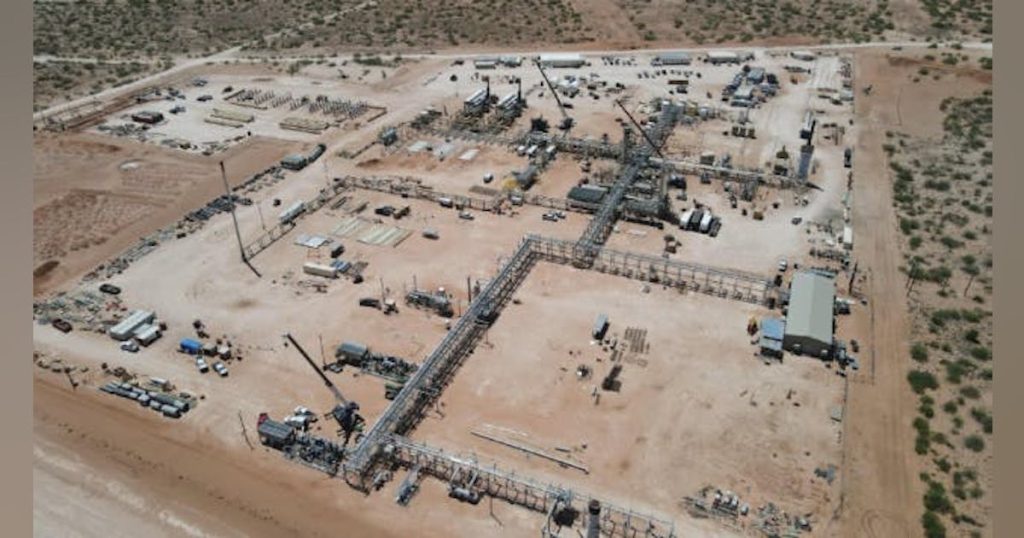Second expansion
Industry estimates suggest more than 7,500 remaining well locations and at least six geologic production benches could be developed across the region, given additional treating and AGI-CCS well capacity tailored to high concentrations of CO2 and H2S. On this basis, Northwind also announced in March 2025 reaching final investment decision to move forward with a second-phase expansion that would double the Titan complex’s amine-treating capacity to 400 MMcfd by 2026.
On Mar. 17, the operator completed issuance of a new $700-million senior-secured first lien term loan, the net proceeds of which Northwind will use to repay existing financing commitments as well as help fund the proposed buildout.
While Northwind did not reveal further details regarding the planned expansion, the New Mexico Environmental Department (NMED) on Apr. 15 published a copy of the operator’s revised New Source Review permit application for the project as part of a required 30-day public comment period.
The application states the project—officially named Titan Treater Plant 2—entails the addition of a 220-MMcfd sour-gas treating plant designed to handle high-pressure inlet field gas that, upon entering the plant, will be compressed using gas-fired engines.
Post-compression, the inlet gas will travel to a dual-unit amine-treatment system for CO2 and H2S removal, after which the resulting acid-gas stream will be directed to five electric-driven compressors (including a spare unit), that will inject the acid gas underground via AGI wells.
The sweetened gas leaving the amine-treating units will first be sent through a triazine contact tower to remove any residual sulfur compounds, after which the gas will be dehydrated using triethylene glycol units and compressed via gas-fired turbines for sales.
Condensate separated in the inlet-slug catcher will undergo further processing in a sour-condensate stabilization train, with stabilizer overhead gas to be recycled into the plant inlet via three electric-driven compressors.
Stabilized condensate will be stored in four 1,000-bbl tanks to await being pumped offsite. In case of pipeline unavailability, however, the stabilized condensate will be loaded via truck for offsite delivery.
Any emissions from this stage of the process will be routed to the tank header via a vapor return line.
Liquids collected via the plant’s closed-drain system will be directed to two 400-bbl slop-water tanks and hauled offsite on trucks.
The plant will include a redundant vapor-recovery unit to control emissions by routing vapors
from the condensate and slop water tanks as well as truck loading back to the inlet.
Major equipment to be added as part of the new plant includes:
Seven 2,065-hp compressor engines.
Five 1,380-hp compressor engines.
Six turbines rated at 6,370 hp each for power generation.
Two triethylene glycol dehydrators and two associated glycol regenerator heaters.
One acid-gas flare.
One process flare.
Slop-water loading.
Condensate loading.
Two slop-water storage tanks.
Four condensate storage tanks.
A spent-triazine storage tank.
Five electric-drive acid-gas compressors.
One stabilizer heater.
Three electric-drive stabilizer overhead compressors.
Public comments on the proposed Titan Plant No. 2 were due by May 15 to NMED, which upon
opening the comment period, announced its preliminary determination to issue Northwind an air-quality construction permit for the project on or before July 2, 2025.
Additional plans
Alongside its Titan Plant No. 2 project, Northwind also plans to add an AGI-CCS well and third processing plant to its Delaware basin operations.
As of late-April 2025, the operator was seeking approval of a permit from New Mexico’s Oil Conservation Commission (OCC) for disposal into the proposed Titan AGI #4 well as an additional redundant AGI well. The company also was pursuing approval for a shared maximum daily injection rate of 28.8 MMcfd of TAG for disposal through either or both its existing Salt Creek AGI #2 well and the planned Titan AGI #4 well, acccording to an OCC docket.
The injection stream would consist of TAG comprised of about 80% and 20% CO2 and H2S, respectively. After moving to approve the requested permit pending certain changes at a Mar. 20 meeting, OCC was scheduled to hear a presentation of the final amended order at its Apr.
21 meeting.
In mid-March, Northwind said it also is building a 75-MMcfd gas-treatment complex in northern Lea County that will be known as the Pelham complex. While project details remain unavailable, Pelham is one of the five compressor-station locations Northwind operates in the region (Fig. 5).

